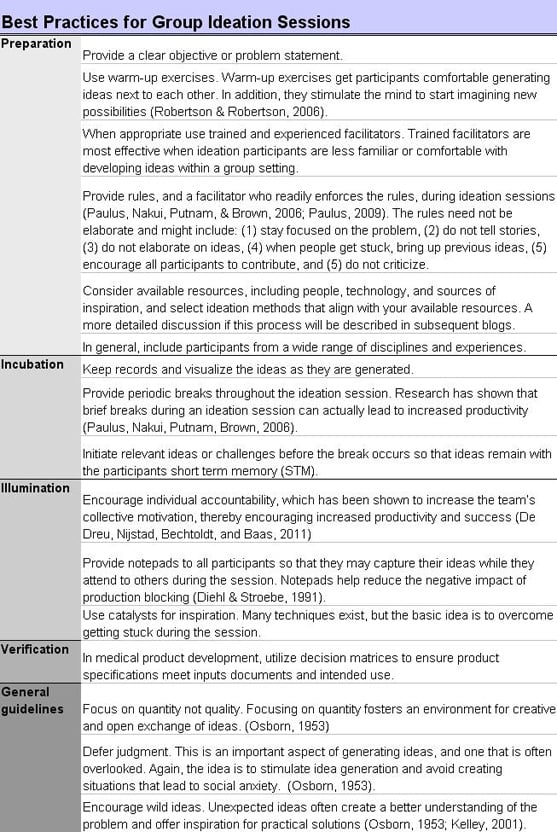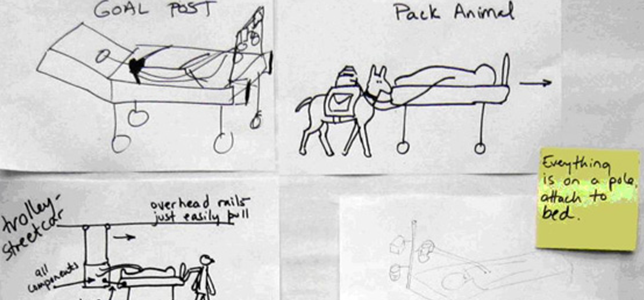The concept of generating ideas within a group environment is nothing new to product development. Alex Osborn popularized the process and contributed a set of highly influential rules in 1953. Since then, a wide range of techniques have been developed to help product development teams develop novel ideas effectively and efficiently. Unfortunately, few design professionals are aware of these methods, and even fewer understand the elements of creativity to help make ideation sessions more productive. This blog will be one in a series of blogs where I’ll discuss the attributes of creative ideation within the context of medical product development. My goals are to provide insight that will help development teams select appropriate ideation methods and, just as importantly, modify existing methods to meet their unique needs.
To begin I’ll provide a brief overview of the literature on creativity and innovation from a cognitive and social psychology perspective to see how recent thinking might affect group ideation sessions. In subsequent blogs I’ll dive deeper into elements of creativity and innovation and introduce a framework for conceptualizing and selecting ideation methods. It is important for me to point out that my research and thoughts are focused on medical product development, which provides a unique set of challenges in the product development industry. With that noted, the core objective of any ideation session is to come up with many creative ideas, or ideas that will somehow add value to the individual or organization trying to solve a problem. It is my hope that by addressing this topic, readers will be able to conduct more successful ideation sessions.
Creativity and the Value of Generating Ideas
There is an assumption that more ideas lead to better ideas. Much of this derives from Linus Pauling’s ubiquitous quote, “The best way to get a good idea is to get lots of ideas,” (in Sharp, Rogers, & Preece, 2007, p. 417). There is, however, research to the contrary. Nevertheless, in medical product development, more ideas lead to better decision making, and the FDA likes to see a process for decision making.
Ideas alone are not inherently valuable. Creative ideas must be implemented; that is, they must be realized through some tangible, usable, and beneficial product or service. To clarify, “…creativity broadly refers to the generation of novel approaches or ideas; innovation refers to the application of ideas in a specific context,” (Biskjaer, Dalsgaard, & Halskov, 2010, p. 12). Creative ideas must lead to innovation.
Clearly, organizations would not exist without their ability to innovate—to generate new products, services, or experiences. There is an implied conflict, of course, because organizations must balance creativity with process optimization. One goal of group idea generation sessions, then, is to come up with creative ideas effectively and efficiently. Finally, creativity requires knowledge and a way to explore that knowledge. The process by which we explore that knowledge effectively, whether as an individual or a group of individuals, is the focus of applied group creativity. The exploration of knowledge starts with developing alternatives.
Forms of Creativity
According to the literature, there are a limited number of ways in which creative ideas are generated. This fact has important implications for the way in which ideation sessions should be conducted. For example, if the goal is to simply redesign an existing medical product, designers should select ideation methods that are more grounded in tradition. Developing a new product from scratch, however, might require a method focused on transcendence. I’ll define the important elements of ideation sessions for medical products in later blogs. Boden (2004) describes three general forms of creativity:
- Unfamiliar combinations of familiar ideas. Similarly, Sharp, Rogers, and Preece discuss the value of the cross fertilization of ideas from different applications (2007).
- Exploring conceptual spaces. This method suggests working within a structured style of thought to deliver ideas that have not been previously conceptualized. In general, product evolution occurs through use, observation, and drawing on knowledge from similar problems.
- Transforming the space. One challenge is for people to overcome expectations of what’s possible. Transformation includes ideas that could not have been conceptualized using the existing conceptual framework. Many ideation sessions focused on the future try to transform the space (see, for example, Nathan, Klasnja, & Friedman, 2007).
The Creative Process
Most of the available research aligns with Osborn’s initial observation that creative ideation involves a series of cognitive processes which are not necessarily performed in sequence. Osborn refers to these processes as fact-finding, idea-finding, and solution-finding. (Osborn includes verification within the solution finding process.) These ideas align closely with more recent descriptions of cognitive tasks including preparation, incubation, illumination, and verification (Boden, 2004). In addition, there are numerous sub-tasks including, but not limited to, gathering and analyzing pertinent data, selecting ideas internally, idea production, evaluation, adoption, and decision-making. In most cases these cognitive processes do not align strategically with ideation sessions (Maiden, Robertson, & Gizikis, 2000), but some of the more structured ideation sessions have tried to map the steps in the process to the cognitive tasks outlined above (see, for example, Jungk and Müllert in Biskjaer, Dalsgaard, and Halskov, 2010). However, the research results are conflicting, and more research is necessary to see if ideation sessions are more productive when they align closely with cognitive theory.
Importantly, the creative process as we know it has informed several important best practices that should be considered during any ideation session. I’ll conclude this blog with a short list of best practices for ideation sessions. This list is preliminary. I invite readers to add best practices and ideas from their own experiences. The next blog in this series will discuss the value and specific challenges, both social and cognitive, of generating ideas within groups.

References
Biskjaer, M.M., Dalsgaard, P., & Halscov, K. (2010). Creativity Methods in Interaction Design. DESIRE '10 Proceedings of the 1st DESIRE Network Conference on Creativity and Innovation in Design 12-21.
Boden, M.A. (2004). The Creative Mind: Myths and Mechanisms (2nd ed.). New York, NY: Routledge.
Kelley, T. (2001). The Art of Innovation. New York, NY: Doubleday.
Maiden, N., Robertson, S., & Gizikis, A. (2004). Provoking creativity: Imagine what your requirements could be like. IEEE Software, 21(5). 1-13. doi: 10.1109/MS.2004.1331305
Nathan, L.P., Klasnja, P.V., Friedman, B. (2007). Value scenarios: A technique for envisioning systemic effects of new technologies. CHI '07 Extended Abstracts on Human Factors in Computing Systems (pp. 2585-2590). New York, NY. doi: 10.1145/1240866.1241046
Osborn, A.F. (1963). Applied Imagination: Principles and Procedures of Creative Problem-Solving (3rd ed.). United States of America: Charles Scribner’s Sons.
Sharp, H., Rogers, Y., & Preece, J. (2007). Interaction Design: Beyond Human-Computer Interaction (2nd ed.). West Sussex, England: John Wiley & Sons Ltd.
